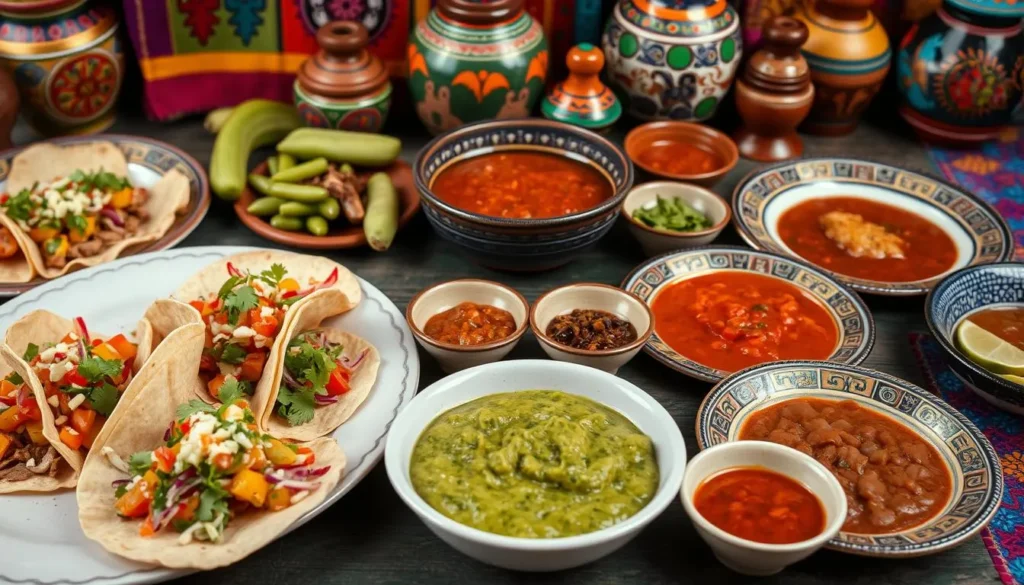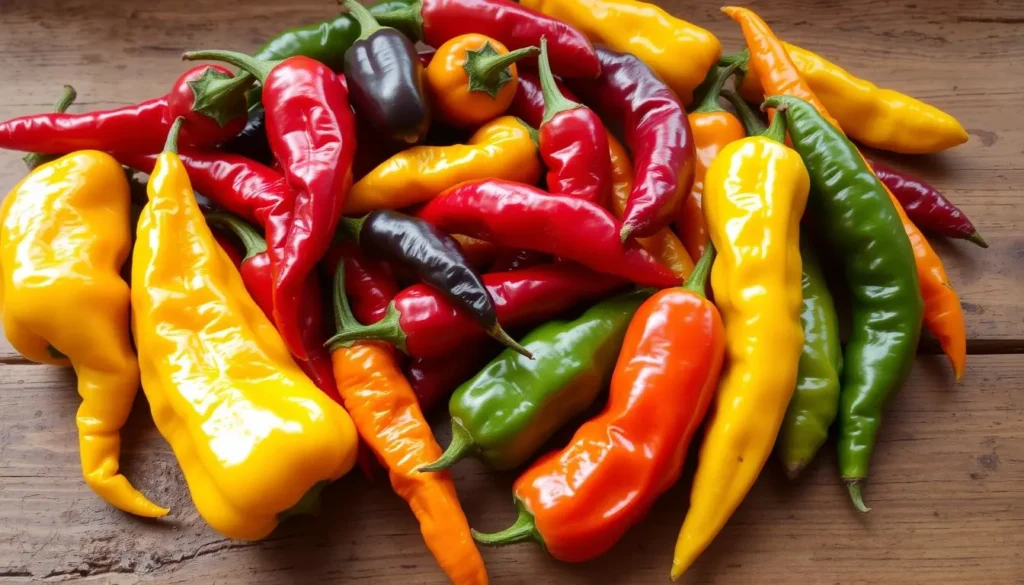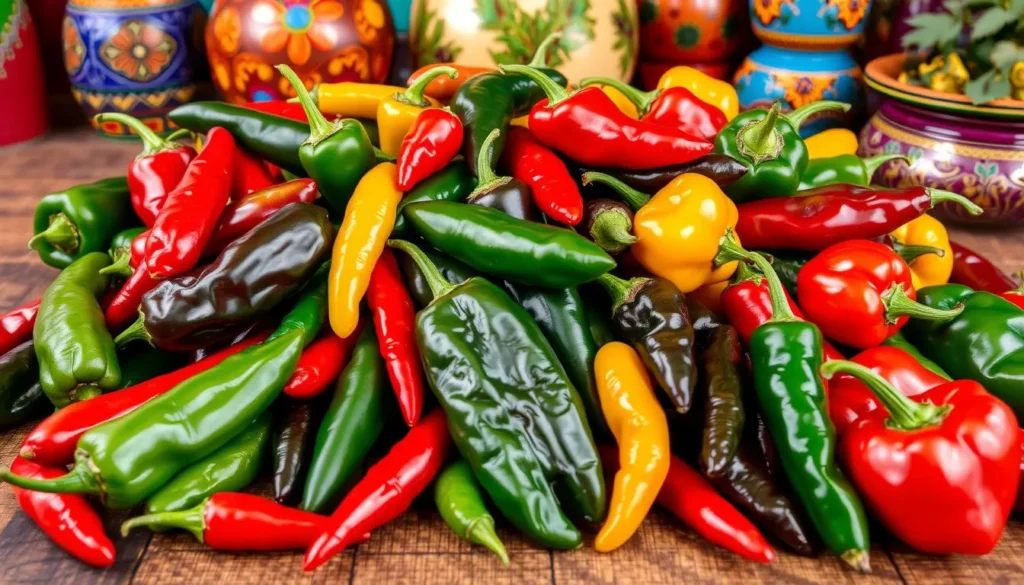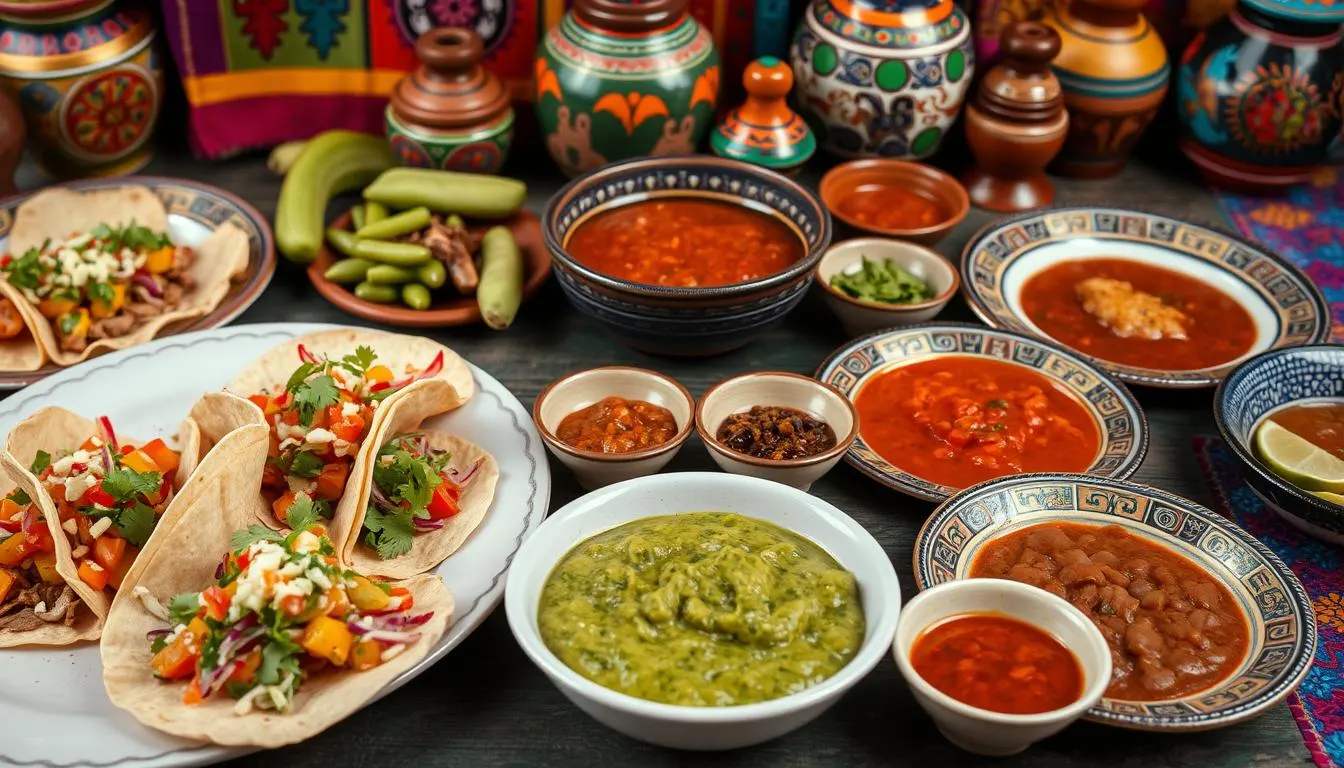Growing up in a Mexican household, I was always surrounded by the smell of chili peppers and colorful sauces. The flavors of Mexico are special to me, exciting my taste buds with spice, sweetness, and depth. Exploring Mexico’s diverse food scene has shown me the complexity and allure of its cuisine.
In this guide, we’ll explore Mexican sauces, their flavors, and the cultural importance of spice. We’ll also look at the different chili peppers that add heat to these dishes. Whether you love spicy food or prefer milder flavors, this article will help you understand Mexican cuisine better.
Related : Authentic Mexican Hot Sauce Recipe – Easy Homemade Salsa

Key Takeaways
- Mexican sauces are known for their varied flavors, from mild to fiery.
- Spice is deeply rooted in Mexican culture and tradition.
- Knowing the different chili peppers and their heat levels helps you pick the right sauce.
- Exploring regional spice variations in Mexican sauces adds depth to the cuisine.
- You can adjust the spice in Mexican sauces to suit your taste.
Understanding the Essence of Mexican Sauces
Explore the world of Mexican sauces, where tradition meets flavor. The mix of chili peppers and spices creates a unique taste experience. These sauces capture the heart of Mexican cuisine.
Traditional Ingredients in Mexican Sauces
Mexican sauces start with a blend of ingredients passed down through generations. Chili peppers are key, with each type adding its own heat and taste. Tomatoes, onions, garlic, and herbs like cilantro and oregano add depth. Spices like cumin, coriander, and cloves bring out the complexity.
Cultural Significance of Spice in Mexican Cuisine
Chili peppers and spices in Mexican sauces hold a special place in culture. They are not just for flavor but also for their health benefits and connection to the land. Enjoying these sauces is a way to celebrate Mexico’s vibrant heritage and spirit.

“Spice is the essence of Mexican cuisine, infusing each dish with a sense of place and a touch of the divine.”
Types of Mexican Chili Peppers and Their Heat Levels
Mexican cuisine is known for its vibrant flavors, and chili peppers play a key role. These peppers come in many varieties, each with its own heat level. Let’s explore the world of Mexican chili peppers and their heat tolerance.
The Anaheim and Pasilla peppers are milder, adding a gentle warmth to dishes. Moving up the scale, the Jalapeño and Serrano peppers offer a medium heat. This heat can add excitement to your meals.
For those who dare, the Habanero and Ghost Pepper are the hottest. They have intense, fiery flavors. These peppers need careful use because their heat can overpower a dish.
Whether you like mild or hot, Mexican peppers offer a wide range of flavors. Each type adds a unique taste and heat level. This lets you tailor your Mexican dishes to your liking.

“The true essence of Mexican cuisine lies in the harmonious balance between the bold, piquant flavors of chili peppers and the other traditional ingredients.”
Popular Mexican Sauces and Their Spice Rating
Mexican food is known for its bold flavors and spicy sauces. These sauces range from mild and creamy to very hot. They are key to many traditional Mexican dishes. Let’s look at some popular sauces and their heat levels to help you find what you like.
Mild Mexican Sauces
For those who like less spice, here are some mild options:
- Salsa Verde: A tangy sauce with tomatillos, garlic, and cilantro.
- Crema: A creamy sauce that adds richness to dishes.
- Guacamole: A favorite dip made from avocados, customizable to your taste.
Medium Heat Sauces
For a bit more heat, try these medium sauces:
- Pico de Gallo: A fresh salsa with tomatoes, onions, cilantro, and jalapeño.
- Salsa Roja: A classic red sauce with roasted tomatoes, garlic, and chili peppers.
- Mole Poblano: A complex sauce with chili peppers, nuts, spices, and chocolate.
Hot and Extra Hot Options
For those who love intense heat, here are some fiery sauces:
| Sauce | Spice Level | Key Ingredients |
|---|---|---|
| Habanero Salsa | Extra Hot | Habanero peppers, onions, tomatoes, cilantro |
| Salsa Macha | Hot | Chili peppers, garlic, olive oil, vinegar |
| Chili de Árbol Salsa | Hot | Chili de árbol peppers, garlic, tomatoes, onions |
Keep in mind, the heat of these sauces can vary. It’s wise to start with a small amount. This way, you can adjust to your liking.
Is Mexican Sauce Spicy? Breaking Down the Heat Factors
When we talk about Mexican food, many wonder if the sauces are spicy. The truth is, it’s not a simple yes or no. The spiciness of Mexican sauces depends on many things.
Chili peppers are a big factor in how spicy a sauce is. Mexican cuisine is famous for its many chili peppers, each with its own heat level. The choice and mix of these peppers greatly affect the sauce’s spiciness.
How the sauce is made also matters. Sauces that are blended tend to have even heat, while those with whole peppers can be spicier in some spots.
Where in Mexico the sauce comes from also plays a part. Different areas of Mexico have their own spice levels, with northern and southern parts having unique flavors.
Remember, how spicy something tastes is different for everyone. What one person finds very hot, another might just find a bit spicy. Knowing your own spice level and the heat of Mexican sauces can help you find the perfect flavor for you.
| Spice Level | Description | Examples |
|---|---|---|
| Mild | Gently seasoned with a subtle heat | Salsa verde, Tomatillo salsa |
| Medium | Moderately spicy, with a noticeable kick | Enchilada sauce, Adobo sauce |
| Hot | Intense and fiery, with a lingering heat | Habanero salsa, Chili de árbol sauce |
| Extra Hot | Extremely spicy, challenging heat tolerance | Scorpion pepper salsa, Mayan-style habanero sauce |
In short, the spiciness of Mexican sauces is complex. Knowing the heat levels and your own tolerance can help you enjoy the rich flavors of Mexican food. You’ll find the perfect sauce for your taste.
Regional Variations in Mexican Sauce Spiciness
Mexican cuisine’s spiciness in sauces changes a lot across different regions. Each area in Mexico has its own taste and spice use. This includes chili peppers and other spices.
Northern Mexican Sauce Profiles
In northern Mexico, like Baja California and Sonora, sauces are milder. They use adobo sauces with garlic, cumin, and oregano. But they don’t have much chili pepper. The focus is on rich, savory flavors, not just heat.
Southern Mexican Heat Preferences
On the other hand, southern Mexico, like Oaxaca and Chiapas, loves spicy sauces. They use habanero and chilhuacle peppers, which are very spicy. Their sauces mix hot peppers, spices, and tangy tomatillos or tomatoes.
Coastal Region Sauce Characteristics
The coastal areas, such as the Yucatán and Pacific Coast, have unique sauce flavors. They add citrus, seafood, and tropical fruits to their sauces. This creates a mix of sweet, sour, and spicy.
| Region | Sauce Spice Level | Key Ingredients |
|---|---|---|
| Northern Mexico | Mild | Adobo sauces, garlic, cumin, oregano |
| Southern Mexico | Hot | Habanero, chilhuacle peppers, tomatillos, tomatoes |
| Coastal Regions | Balanced | Citrus, seafood, tropical fruits |
Knowing about Mexican sauce spiciness by region helps you enjoy the diverse flavors. You can find the perfect mix of heat and taste for yourself.
How to Control Spice Levels in Mexican Sauces
Mexican cuisine is all about finding the right spice balance. Whether you love spicy food or prefer it milder, knowing how to adjust the heat in sauces is key. It lets you make dishes that fit your taste perfectly.
Choosing the right chili peppers is a big part of controlling spice. Peppers like jalapeños, serranos, and habaneros have different spice levels and heat tolerance. By picking the right peppers, you can make sauces that match your flavor profiles.
To manage spice, balance the sauce’s other ingredients. Adding acidic things like lime juice or tomatoes can balance the heat. On the other hand, creamy ingredients like sour cream or avocado can soften the spice.
“The key to controlling spice in Mexican sauces is to experiment and find the right balance of ingredients that suits your personal taste preferences.”
If your sauce is too spicy, there are ways to fix it. Adding more liquid like broth or water can reduce the heat. You can also use starchy things like cornstarch or flour to thicken and lessen the spice.
- Carefully select chili peppers based on your desired spice tolerance
- Balance acidic and creamy ingredients to create a harmonious flavor profile
- Adjust the quantity of liquid or starchy elements to tame overly spicy sauces
By trying out these methods, you can control the spice levels in your Mexican sauces. This way, you can make dishes that match your heat tolerance and flavor preferences exactly.
The Scoville Scale and Mexican Peppers
The Scoville scale is key to knowing the heat of Mexican sauces. It was created by American pharmacist Wilbur Scoville. This tool helps us understand the heat of different chili peppers.
Common Mexican Peppers on the Scale
Mexican food is famous for its wide range of chili peppers. Each pepper has its own Scoville heat unit (SHU) rating. Here are some common ones:
- Jalapeño: 2,500 – 8,000 SHU
- Serrano: 10,000 – 25,000 SHU
- Chipotle: 2,500 – 8,000 SHU
- Habanero: 100,000 – 350,000 SHU
- Ghost Pepper (Bhut Jolokia): 850,000 – 1,million SHU
Understanding Heat Measurements
The Scoville scale measures capsaicin, which causes the burning feeling in chili peppers. The higher the Scoville rating, the hotter the pepper. This helps sauce lovers pick the right spice level.
Knowing the Scoville scale and Mexican pepper heat levels makes exploring Mexican sauces fun. It ensures your dishes are both tasty and exciting.
Pairing Mexican Sauces with Different Dishes
Exploring Mexican cuisine means discovering its many sauces. These sauces range from mild and creamy to fiery and bold. They can make any dish better. The trick is to know how to pair them right.
Mexican sauces have different flavors that match various foods. For example, mild and tangy salsa verde is great with grilled meats, fish, and tacos. On the other hand, rich and smoky chipotle sauce is perfect for enchiladas, burritos, and roasted veggies.
| Mexican Sauce | Flavor Profile | Best Pairings |
|---|---|---|
| Salsa Roja | Spicy, tomato-based | Tacos, burritos, eggs |
| Mole Poblano | Rich, complex, chocolate-tinged | Chicken, rice dishes, enchiladas |
| Salsa Verde | Tangy, herbal, mild | Grilled meats, fish, tacos |
| Chipotle Sauce | Smoky, spicy | Burritos, enchiladas, roasted veggies |
When trying out Mexican sauces, think about the heat level and flavor intensity. This ensures a good balance with your dish. For example, a hot habanero salsa might be too much for delicate seafood. But a mild tomatillo sauce might get lost in a big Mexican beef stew.
Mastering Mexican sauce pairings is all about understanding each sauce’s unique flavor and heat. This way, you can take your Mexican cuisine to new heights.
Health Benefits of Spicy Mexican Sauces
Spicy Mexican sauces are more than just a tasty treat. They can actually help your health in many ways. From boosting your metabolism to fighting off free radicals, these sauces are packed with benefits.
One big plus is how they can speed up your metabolism. Chili peppers contain capsaicin, which helps your body burn more calories. This can be great for keeping your weight in check or helping with your fitness goals.
- Capsaicin, the active compound in chili peppers, has been linked to pain relief and reduced inflammation.
- Spicy sauces are rich in antioxidants that can help neutralize harmful free radicals and support overall well-being.
- Consuming spicy foods may trigger the release of endorphins, contributing to a sense of improved mood and reduced stress levels.
Remember, it’s key to enjoy spicy sauces in moderation. Everyone’s tolerance is different. Listen to your body and adjust the spice to what feels right for you.
| Health Benefit | Explanation |
|---|---|
| Metabolism Boost | The capsaicin compound in chili peppers can increase thermogenesis, leading to a temporary spike in calorie burn. |
| Pain Relief and Anti-Inflammation | Capsaicin has been linked to reducing inflammation and providing pain relief. |
| Antioxidant Properties | Spicy sauces are rich in antioxidants that can help neutralize harmful free radicals. |
| Mood Enhancement | Consuming spicy foods may trigger the release of endorphins, contributing to improved mood and reduced stress levels. |
Now you know the health perks of spicy Mexican sauces. Enjoy them with a new appreciation for their health benefits. Add some heat to your meals and enjoy the flavors and benefits they bring.
Conclusion
In this journey through Mexican sauces, you’ve seen the wide range of flavors and spice levels. You’ve learned about the traditional ingredients and the role of chili peppers in Mexican cuisine. This has given you a deeper understanding of what makes Mexican sauces so special.
You’ve explored the different types of Mexican chili peppers and their heat levels. You’ve also seen how popular sauces show the variety of spiciness. Regional differences, cooking methods, and personal tastes all add to the rich experience of Mexican flavors.
Now, as you explore the vibrant tastes of Mexico, remember spice is just one part of the story. Enjoy the chance to try new things and discover the unique flavors of each sauce and dish. Whether you like it mild, medium, or hot, Mexican sauces are a flavorful journey waiting for you.
FAQ
What is the typical spiciness level of Mexican sauces?
Mexican sauces can range from mild to very spicy. This depends on the ingredients and where they come from. Some are gentle, while others pack a lot of heat.
What are the common ingredients in Mexican sauces?
Mexican sauces usually have chili peppers, tomatoes, onions, garlic, and herbs. The mix of these can change the flavor and heat level.
How does the spiciness of Mexican sauces compare to other cuisines?
Mexican sauces are often spicier than others because of chili peppers. But, the heat can vary. Some are mild, while others are very hot.
What are some of the most common Mexican chili peppers used in sauces?
Jalapeños, serranos, chipotles, and poblanos are common in Mexican sauces. They range from mildly spicy to very hot.
How can the spice level of Mexican sauces be adjusted?
You can change the spice by using more or less chili peppers. Adding vinegar, lime juice, or dairy can also help. Cooking methods can also impact the heat.
Are there any regional differences in the spiciness of Mexican sauces?
Yes, the spiciness varies by region. Northern sauces are often milder. Southern and coastal areas prefer hotter sauces. This is due to local tastes and recipes.
What are the health benefits of consuming spicy Mexican sauces?
Spicy sauces might boost metabolism and reduce inflammation. They also have antioxidants from chili peppers. But, it’s key to eat them in moderation because everyone’s tolerance is different.

